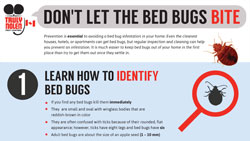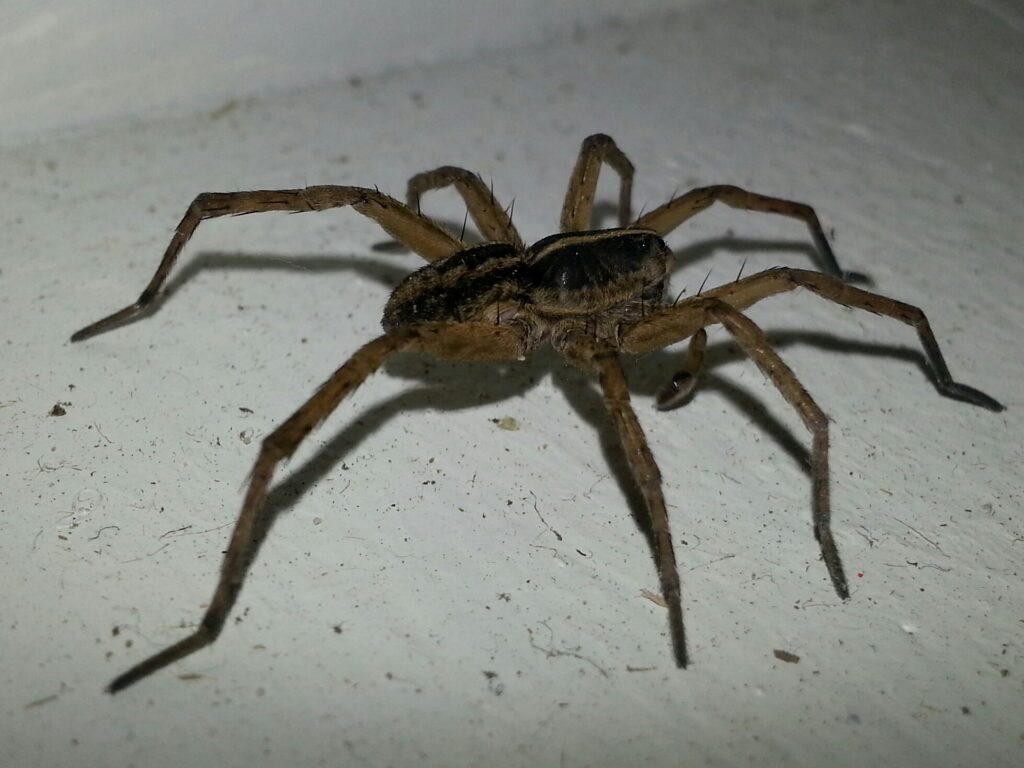A BED BUG RESURGENCE
[caption id="attachment_1271" align="alignleft" width="250"] Click image for full infographic[/caption]
The bed bug has made a significant resurgence in recent years in Canada due to an increase in international travel, more targeted pest control products and methods, and a lack of public awareness about bed bug prevention methods. The problem has been growing as these insects have been multiplying in record numbers in cities and smaller communities across the country. The assumption one must be a poor housekeeper or have poor hygiene to have these pests is simply untrue. Further, bed bug infestations have no link to socioeconomic status. You can come into contact with bed bugs just about anywhere and so it is possible for anyone to become infested.
Bed bugs can’t fly, so they spread one of two ways: either crawling to a new location or are carried from place to place. Bed bugs can migrate to an adjacent unit through hallways, plumbing, electrical lines, etc. Moreover bed bugs like to hide and are excellent hitch hikers. These insects can climb into and hide in bags, luggage, clothing, bedding, furniture, boxes, and other belongings and are then relocated by a person. These small insects travel easily and multiply quickly.
Although bed bugs suck blood like other human parasites, there has been no evidence to indicate that bed bugs spread diseases. Bed bug bites, however, can cause an allergic reaction in some people similar to a mosquito bite. Frequent scratching of the bite marks or picking the scabs can cause infections. And people with severe and/or repeated infestations can feel anxious, worried, or ashamed.
Click image for full infographic[/caption]
The bed bug has made a significant resurgence in recent years in Canada due to an increase in international travel, more targeted pest control products and methods, and a lack of public awareness about bed bug prevention methods. The problem has been growing as these insects have been multiplying in record numbers in cities and smaller communities across the country. The assumption one must be a poor housekeeper or have poor hygiene to have these pests is simply untrue. Further, bed bug infestations have no link to socioeconomic status. You can come into contact with bed bugs just about anywhere and so it is possible for anyone to become infested.
Bed bugs can’t fly, so they spread one of two ways: either crawling to a new location or are carried from place to place. Bed bugs can migrate to an adjacent unit through hallways, plumbing, electrical lines, etc. Moreover bed bugs like to hide and are excellent hitch hikers. These insects can climb into and hide in bags, luggage, clothing, bedding, furniture, boxes, and other belongings and are then relocated by a person. These small insects travel easily and multiply quickly.
Although bed bugs suck blood like other human parasites, there has been no evidence to indicate that bed bugs spread diseases. Bed bug bites, however, can cause an allergic reaction in some people similar to a mosquito bite. Frequent scratching of the bite marks or picking the scabs can cause infections. And people with severe and/or repeated infestations can feel anxious, worried, or ashamed.
BED BUG FACTS
- Bed bugs are small, oval, brownish parasitic insects that feed on the blood of sleeping animals or humans. They have wingless bodies that are reddish-brown in color.
- Bed bugs are often confused with ticks because of their rounded, flat appearance. However, ticks have eight legs and are arachnids (relatives of the spider). Bed bugs have six legs and are insects.
- Adult bed bugs are about the size of an apple seed (1 – 10 mm / 0.25 – 0.5 inches). After feeding, their bodies swell dramatically and are reddish in color.
- They are experts at hiding and can squeeze into tiny cracks and crevices as small as the width of a credit card. Bed bugs prefer dark areas and tend to hide in and around the bed, headboard, nightstand, in mattress seams, and pillow top tufts.
- They do not jump or fly but are fast-moving and good runners; they will travel up to 15 feet for a blood meal.
- They are most active at night and usually feed about an hour before dawn.
- They can easily move between adjacent rooms or units via wall voids and electrical sockets.
- Although they typically feed on human blood every few days (5-10 days), they are capable of surviving several weeks up to a year and a half without feeding.
- Adults usually live for around 10 months, but can live for a year or more in a home where the environment is good for reproduction (with temperatures between 21°C and 28°C).
- Each female lays at least 250 eggs in her lifetime. The eggs usually hatch in 10 days. The eggs have a sticky coating and are laid in cracks and crevices and other hidden locations.
BED BUG FEAST
Bed bugs prefer to feed at night and are attracted by body temperature, natural body odor, and the carbon dioxide we exhale. Although bed bugs most often feed on a sleeper’s exposed skin including the host’s head, face, neck, and arms, they will feed on both people and pets. The bed bugs’ mouthparts are modified for piercing and sucking. When a bed bug bites, they inject saliva containing an anesthetic that prevents a person from realizing they are being bitten and an anticoagulant to thin the blood and increase the size of its blood meal. The bugs feed in about five minutes until fully engorged and then crawl back to its hiding place. Bed bug bites may not be noticed right away because bed bugs typically feed at night when people are asleep. Anywhere from one to 14 days after the initial bite, red, itchy bite marks typically appear. Later the bites may develop into a hard bump with a whitish center which can itch for days. The bite marks are similar to those of fleas and mosquitoes. Some people do not react at all to the bites, while others may have small skin reactions. In rare cases, some people may have severe allergic reactions. To avoid infection, try not to scratch the bites and keep the bite sites clean. Using antiseptic creams or lotions, as well as antihistamines, may help. Bed bugs are not known to spread disease however their presence may cause itching, emotional distress, and lack of sleep. They live between wooden floorboards or in furniture, bed frames, mattresses, or behind peeling paint.SIGNS OF INFESTATION
Bed bugs have quickly adapted to thriving in the human environment; they have learned how to live unseen. Their flattened bodies allow them to hide in extremely small locations during the day; they generally avoid light. Bed bugs prefer locations where they can hide easily and feed regularly. A tiny infestation could cost thousands of dollars in professional pest control treatments, laundry, alternate lodging (hotels), and specialized mattress covers. Knowing what clues to look for is the first step in identifying and controlling bed bugs. Signs of an infestation typically include:- Bites on your body – typically a line of faded red specs
- Dark red blood stains on bed sheets
- Small black or brown spots (i.e., dried feces) that look like mold or ground pepper on the bed or wall
- Piles of the bed bugs’ light brown shed skins (exoskeletons) after molting.
- An unusual smell – a sweet and musty, yet offensive odour that some compare to overripe raspberries.
PREVENTION
Prevention is essential to avoiding a bed bug infestation in your home. Even the cleanest houses, hotels, or apartments can get bed bugs, but regular inspection and cleaning can help you prevent an infestation. It is much easier to keep bed bugs out of your home in the first place than try to get them out once they settle in.- One of the best ways to control a bed bug infestation is to spot the problem early and act quickly.
- Learn how to identify bed bugs. If you find any bed bugs kill them immediately.
- Get rid of places where bed bugs can hide.
- Get rid of clutter. A cluttered home provides more places for bed bugs to hide and makes locating and treating them harder.
- Vacuum often, including under and behind beds.
- Seal all cracks and crevices on wooden bedframes, headboards, baseboards, walls, ceilings, windows, and door frames so no bugs can get in.
- Repair or remove peeling wallpaper and tighten loose electrical faceplates.
- Be careful about what you bring into your home.
- Bed bugs are an equal-opportunity pest and can easily be transported from place to place as people Thoroughly inspect every item you bring into your home for the first time, including used books, furniture, and garage sale or antique store furniture. Be extra cautious with second-hand items particularly furniture or electronics, as they are prime hiding places for bed bugs.
- Check out our infographic to see where bed bugs are most likely to enter your home.
- Be extra cautious when traveling.
- Thoroughly inspect your hotel room and bed before unpacking. For more tips from the Public Health Agency of Canada on avoiding bed bugs when traveling.
- Check Canadian Bed Bug Reports website. It warns travelers about hotels in Canada that have had bed bugs reported.
- Check your home regularly for bed bugs.
- Bed bugs love gaps in just about everything, so check:
- Under wallpaper, behind picture frames, in electrical outlets and behind switch plates, inside box springs, in mattress pads, and in night tables.
- In beds (mattress and box spring seams, creases, tufts, and folds) bedframes, headboards
- Nightstands, end tables including drawers
- In electronics like your alarm clock
- Couches and upholstered furniture, inside hollow legs of furniture
- Around doorframes and window sills and behind baseboards
- Around pipes (water, drain, electrical conduits)
- If bed bugs are on the walls, they could also be hiding in picture frames, light fixtures, smoke detectors, in the folds of drapery or curtains, or other wall-mounted items.
- Bed bugs hiding in ceiling lights could mean that they are entering from a room above yours.
- Check the areas where your pet sleeps as well.
- Bed bugs love gaps in just about everything, so check:

